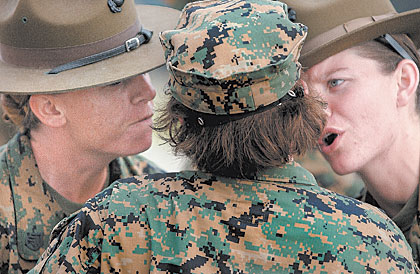
WHEN I WAS IN ARMY ROTC at Gonzaga University, we spent one spring weekend at Fort Lewis, Wash. at an experience I like to call, "hell" -- but for the blog, I'll call it "Spring Camp." This camp was an exercise in will, determination and ferocity for the more than 400 cadets who attended. It required dexterity, leadership, endurance, cardiovascular and muscular conditioning, and an iron will as we were put to the test--daily--by our drill sergeants, fellow cadet leaders, and officers.

Not everyone has the opportunity to experience the hell of Spring Camp -- but by now you've undoubtedly heard of BOOT CAMP, (and its distant cousin, TAE BO or CARDIO KICKBOXING). I've trained dozens of clients who've participated in such "camps" and experiences. Some folks swear by them -- the camaraderie, the "hoo-hah" spirit which mimicks the military's own effective PT training can be alluring. However, I have justifiable concerns about the safety of these "camps" after working with many clients who have found themselves dehydrated, or worse, injured, by the "camp's" intensity.

To be sure, any participation in an organized cardiovascular workout (the military's notwithstanding) involves some degree of risk. But remember, these environments are unlike any other. It's vital that if you're participating in this type of training that you remember the following things:
1) YOU ARE THE BEST JUDGE OF YOUR ABILITIES. No matter how hard a "boot camp instructor" pushes you, it is vital that you monitor your own energy and exertion.
2) YOU MUST STAY HYDRATED. It is absolutely vital that you do not fall victim to "group think" in a boot camp environment. The 20-year-old athlete may not need as much water as you. You must keep yourself hydrated to prevent yourself from overheating.
3) ASK QUESTIONS BEFORE YOU SIGN UP. Make sure the facility has adequate circulation, air conditioning, ventilation. Verify that all of the instructors are certified AND insured.
4) WHEN IN DOUBT, BE CONSERVATIVE. It's better for you to lag behind, take a break, get some water, or just stop if you need to. It's not worth injuring yourself just to impress the drill instructor.
5) USE PROPER FOOTWEAR. You'll need to make sure that your shoes are in working order. This will protect your ankles, feet, and joints from undue wear and tear.
I've seen far too many clients and friends start BOOT CAMP and similar programs and then fall prone to injury, overtraining, or get disheartened. Be careful when it comes to "military style" group exercise.
 THE LAST TWO YEARS HAVE BEEN BIG ONES FOR ME PERSONALLY....Building my Los Angeles fitness practice, working with the X PRIZE to help launch the private space tourism industry, and about to open my second studio, in Glendale, California next month.
THE LAST TWO YEARS HAVE BEEN BIG ONES FOR ME PERSONALLY....Building my Los Angeles fitness practice, working with the X PRIZE to help launch the private space tourism industry, and about to open my second studio, in Glendale, California next month. 







